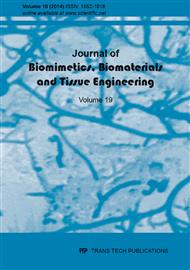[1]
Eny. Kusrini, Aida R. Pudjiastuti, Sotya. Astutiningsih and Sri. Harjanto, International Conference on Chemical, Bio-Chemical and Environmental Sciences (ICBEE'2012) December 14-15, 2012 Singapore.
Google Scholar
[2]
Muhammad KusumawanHerliansyah, CandraMuzafar, Alva EdyTontowi, Proceedings of the Asia Pacific Industrial Engineering & Management Systems Conference 2012V. Kachitvichyanukul, H.T. Luong, and R. Pitakaso Eds.
Google Scholar
[3]
M. E. Bahrololoom, M. Javidi, S. Javadpour and J. Ma, Journal of Ceramic Processing Research. Vol. 10, No. 2, p.129~138 (2009).
Google Scholar
[4]
M. Markovic, B.O. Fowler and M.S. Tung, J. Res. Natl. Inst. Stand. Technol. 109 (2004) 553-568.
Google Scholar
[5]
K. Haberko, M.M. Bucko, J. Brzezinska-Miecznik, M. Haberko, W. Mozgawa, T. Panz, A. Pyda and J Zarebski, J. Europ. Ceram. Soc. 26 (2006) 537-542.
DOI: 10.1016/j.jeurceramsoc.2005.07.033
Google Scholar
[6]
S. Joschek, B. Nies, R. Krotz, and A. Gopferich, Biomaterials 21 (2000) 1645-1658.
Google Scholar
[7]
Robert Kane, Peter X. Ma, Materials Today, Vol. 16(11), 2013, p.418.
Google Scholar
[8]
Joon Park, r. S. Lakes, Biomaterials An Introduction, 3rd ed. Springer, (2007).
Google Scholar
[9]
Sameer R. Paital, Narendra B. Dahotre, Materials Science and Engineering, R 66, 2009, p.6.
Google Scholar
[10]
Joseph D. Bronzino, The Biomedical Engineering Handbook, 2nd ed., CRC Press, Boca Raton, FL., (2000).
Google Scholar
[11]
Naseer A. M. Barakat, MyungSeobKhil, A. M. Omran, Faheem A. Sheikh, Hak Young Kim, Journal of Materials Processing Technology, Vol. 209, 2009, p.3409.
Google Scholar
[12]
A. Tampieri, G. Celloti, S. Spiro, C. Mingazzini, Mater. Chem. Phys. Vol. 64, 2000, p.54.
Google Scholar
[13]
M. Markovic, B. O. Fowler, M. S. Tung, J. Res. Natl. Inst. Stand. Technol. Vol 109, 2004, p.553.
Google Scholar
[14]
N. Y. Mostafa, Mater. Chem. Phys. Vol. 94, 2005, p.333.
Google Scholar
[15]
M. Manso, C. Jimenez, C. Morant, P. Herrero, J. M. Martinez-Duart, Biomaterials, Vol. 21, 2000, p.1755.
Google Scholar
[16]
X. Pang, I. Zhitomirsky, Mter. Chem. Phys. Vol. 94, 2005, p.245.
Google Scholar
[17]
M. Wei, A. J. Ruys, B. K. Milthrope, C. C. Sorrell, J. H. Evans, J. Sol-Gel Sci. Technol. Vol. 21, 2001, p.39.
Google Scholar
[18]
M. Wei, A. J. Ruys, B. K. Milthrope, C. C. Sorrell, J. Mater. Sci. -Mater. Med. Vol. 16, 2005, p.319.
Google Scholar
[19]
X. F. Xiao, R. F. Liu, Mater. Let. Vol. 60, 2006, p.2627.
Google Scholar
[20]
D. M. Liu, Q. Yang, T. Troczynski, Biomaterials, Vol. 23, 2002, p.691.
Google Scholar
[21]
Y. Han. S. Li. X. Wang. L. Jia, j. He, Mater . Res. Bull. 42, 2007, p.1169.
Google Scholar
[22]
L. L Lench, J Wilson, An International to Bioceramics, World Scientific Inc, (1993).
Google Scholar


